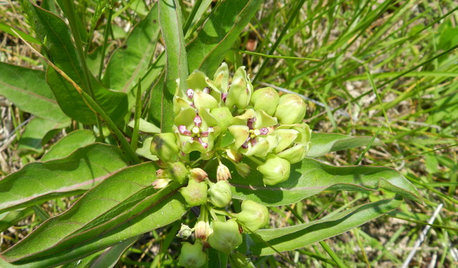Monarchs Declining!!!
docmom_gw
11 years ago
Related Stories

GARDENING FOR BUTTERFLIESBe a Butterfly Savior — Garden for the Monarchs
Keep hope, beauty and kindness alive in the landscape by providing a refuge for these threatened enchanters
Full Story
CALIFORNIA NATIVE PLANTSGreat Design Plant: Asclepias Is Attractive to Monarch Butterflies
Increase monarch butterfly populations in California by planting stunning native milkweeds
Full Story
FLOWERS AND PLANTSHelp Monarchs and Other Butterflies by Planting Common Milkweed
Summer-blooming Asclepias syriaca is an important larval host plant for the monarch butterfly and attracts a number of pollinating insects
Full Story
GARDENING GUIDESGreat Design Plant: Asclepias Incarnata for a Butterfly Garden
Beautiful swamp milkweed makes it easy to help monarchs and other pollinators in eastern U.S. gardens
Full Story
GARDENING GUIDESGreat Design Plant: Asclepias Viridis
Green antelopehorn is a milkweed that is short, drought-tolerant, not aggressive and a monarch favorite
Full Story
GARDENING GUIDES6 Steps to Creating Your Butterfly Garden
Encourage these fanciful winged beauties to visit your garden while helping restore their fragmented habitat
Full Story
GARDENING GUIDESGreat Design Plant: Milkweed
Quit cringing. This not-weed plant is a sight to behold in the garden, has a delicious vanilla scent and is a magnet for butterflies
Full Story
GARDENING GUIDESHow to Find the Right Native Plants for Your Yard
Find plant maps, sale sites and guides that make going native in the garden easier than ever
Full Story
GARDENING GUIDESHow I Learned to Be an Imperfect Gardener
Letting go can lead to a deeper level of gardening and a richer relationship with the landscape. Here's how one nature lover did it
Full Story
EARTH DAYHow to Design a Garden for Native Bees
Create a garden that not only looks beautiful but also nurtures native bees — and helps other wildlife in the process
Full Story






larry_gene
alch21
Related Professionals
Fillmore Landscape Architects & Landscape Designers · Athens Landscape Contractors · Belmont Landscape Contractors · Broadlands Landscape Contractors · Cambridge Landscape Contractors · Milford Mill Landscape Contractors · Shirley Landscape Contractors · Uxbridge Landscape Contractors · Watertown Landscape Contractors · Weymouth Landscape Contractors · Diamond Bar Fence Contractors · Minneapolis Fence Contractors · Newark Fence Contractors · Bellwood Window Contractors · Gibsonton Window Contractorslinda_tx8
linda_tx8
linda_tx8
MissSherry
butterflymomok
minrose
linda_tx8
linda_tx8
linda_tx8
Tony G
cghpnd
docmom_gwOriginal Author
linda_tx8
cghpnd
Leafhead
cghpnd
Leafhead
docmom_gwOriginal Author
cghpnd
Leafhead
docmom_gwOriginal Author
cghpnd
JessicaBe
butterflymomok
docmom_gwOriginal Author
Leafhead
terrene
Leafhead
terrene
Leafhead
terrene
Leafhead
gardening_NC
Leafhead
docmom_gwOriginal Author
cghpnd
terrene
cghpnd
Leafhead
docmom_gwOriginal Author
cghpnd
Tony G
docmom_gwOriginal Author
linda_tx8
Leafhead
bananasinohio
cghpnd
Tony G